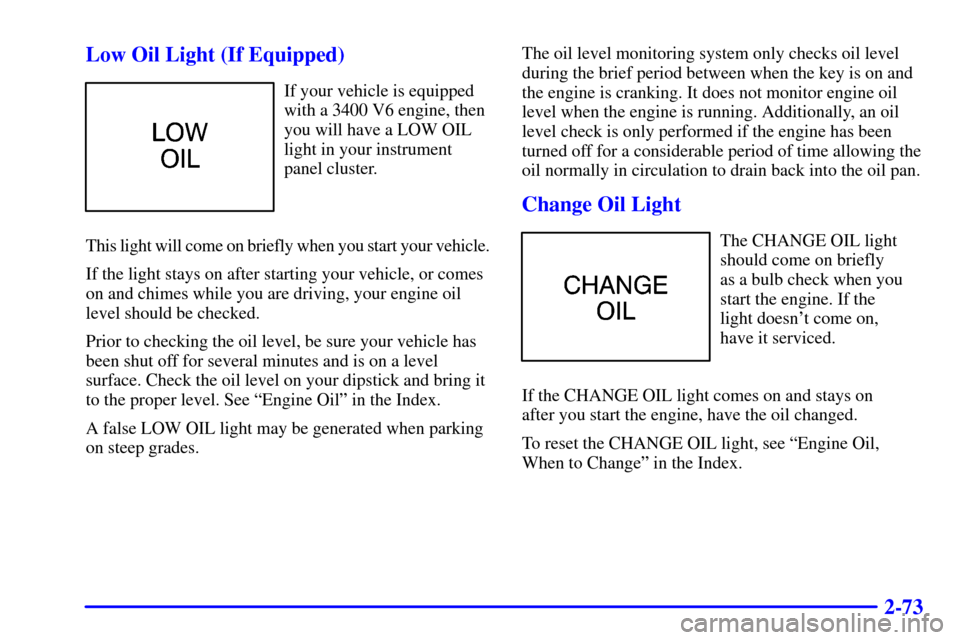Page 135 of 343

2-73 Low Oil Light (If Equipped)
If your vehicle is equipped
with a 3400 V6 engine, then
you will have a LOW OIL
light in your instrument
panel cluster.
This light will come on briefly when you start your vehicle.
If the light stays on after starting your vehicle, or comes
on and chimes while you are driving, your engine oil
level should be checked.
Prior to checking the oil level, be sure your vehicle has
been shut off for several minutes and is on a level
surface. Check the oil level on your dipstick and bring it
to the proper level. See ªEngine Oilº in the Index.
A false LOW OIL light may be generated when parking
on steep grades.The oil level monitoring system only checks oil level
during the brief period between when the key is on and
the engine is cranking. It does not monitor engine oil
level when the engine is running. Additionally, an oil
level check is only performed if the engine has been
turned off for a considerable period of time allowing the
oil normally in circulation to drain back into the oil pan.
Change Oil Light
The CHANGE OIL light
should come on briefly
as a bulb check when you
start the engine. If the
light doesn't come on,
have it serviced.
If the CHANGE OIL light comes on and stays on
after you start the engine, have the oil changed.
To reset the CHANGE OIL light, see ªEngine Oil,
When to Changeº in the Index.
Page 238 of 343

6-
6-1
Section 6 Service and Appearance Care
Here you will find information about the care of your vehicle. This section begins with service and fuel information,
and then it shows how to check important fluid and lubricant levels. There is also technical information about your
vehicle, and a part devoted to its appearance care.
6
-2 Service
6
-3 Fuel
6
-5 Fuels in Foreign Countries
6
-6 Filling Your Tank
6
-8 Filling a Portable Fuel Container
6
-9 Checking Things Under the Hood
6
-13 Engine Oil
6
-20 Engine Air Cleaner/Filter
6
-22 Automatic Transaxle Fluid
6
-23 Manual Transaxle Fluid
6
-23 Hydraulic Clutch
6
-24 Engine Coolant
6
-28 Power Steering Fluid
6
-28 Windshield Washer Fluid
6
-30 Brakes6
-33 Battery
6
-34 Bulb Replacement
6
-39 Windshield Wiper Blade Replacement
6
-40 Tires
6
-51 Appearance Care
6
-51 Cleaning the Inside of Your Vehicle
6
-54 Care of Safety Belts
6
-55 Cleaning the Outside of Your Vehicle
6
-58 Finish Damage
6
-59 GM Vehicle Care/Appearance Materials
6
-60 Vehicle Identification Number (VIN)
6
-61 Electrical System
6
-66 Replacement Bulbs
6
-66 Capacities and Specifications
6
-68 Normal Maintenance Replacement Parts
Page 246 of 343
6-9
Checking Things Under the Hood
CAUTION:
An electric fan under the hood can start up and
injure you even when the engine is not running.
Keep hands, clothing and tools away from any
underhood electric fan.
CAUTION:
Things that burn can get on hot engine parts and
start a fire. These include liquids like gasoline,
oil, coolant, brake fluid, windshield washer and
other fluids, and plastic or rubber. You or others
could be burned. Be careful not to drop or spill
things that will burn onto a hot engine.
Hood Release
To open the hood, do the following:
1. Pull the handle located
under the instrument
panel on the driver's
side of the vehicle.
Page 250 of 343
6-13
Engine Oil
If the LOW OIL light
appears on the instrument
cluster, it means you need
to check your engine oil
level right away.
3400 V6 Engine Only
For more information, see ªLOW OIL Lightº in
the Index.
You should check your engine oil level regularly; this is
an added reminder.
Checking Engine Oil
It's a good idea to check your engine oil every time you
get fuel. In order to get an accurate reading, the oil must
be warm and the vehicle must be on level ground.
2.2L L4
ECOTEC Engine
Page 280 of 343

6-43
Don't reset the tire pressure monitor system without first
correcting the cause of the problem and checking and
adjusting the pressure in all four tires. If you reset the
system when the tire pressures are incorrect, the system
will not work properly and may not alert you when a tire
is low.
Any time you adjust a tire's pressure, rotate your tires,
have one or more tires repaired or replaced, or when any
work is done on your vehicle where tires are removed
you'll need to reset (calibrate) the tire pressure monitor
system. You'll also need to reset the system whenever
you buy new tires and whenever the vehicle's battery
has been disconnected.
To reset (calibrate) the system:
1. Turn the ignition switch to ON (engine not running).
2. Press and release the RESET button located inside of
the driver's side instrument panel fuse block. See
ªInstrument Panel Fuse Blockº in the Index.
The CHANGE OIL light will begin to flash.
3. Press and release the RESET button again.
The CHANGE OIL light will go off, and the LOW
TIRE PRESSURE light will start flashing.4. When the LOW TIRE PRESSURE light is
flashing, press and hold the RESET button until the
chime sounds.
If the LOW TIRE PRESSURE light doesn't go off,
repeat the procedure. If the LOW TIRE PRESSURE
light still remains on, see your dealer for service.
The system completes the calibration process
during driving.
The system normally takes 15 to 20 minutes of driving
in each of three speed ranges to ªlearnº tire pressures.
The speed ranges are 15 to 40 mph (25 to 65 km/h),
40 to 65 mph (65 to 105 km/h) and above 65 mph
(105 km/h). When learning is complete, the system will
alert you after two to eight minutes if a tire is 12 psi
(83 kPa) different from the other three tires. Detection
thresholds may be higher and detection times may be
longer on rough roads, curves and at high speeds. The
system is not capable of detection at speeds greater than
75 mph (120 km/h).